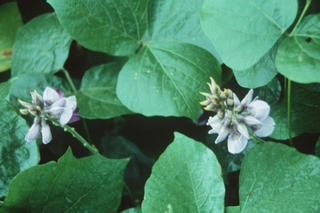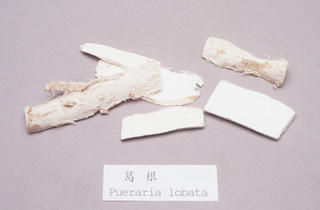Pueraria thomsoni
Contents
Nomenclature
Other Names:
Historical Use of Pueraria thomsoni
Pueraria thomsoni in Traditional Chinese Medicine
Background
Fengegen ·Û¸ð¸ù
Chinese Name (pinyin): Gegen
Chinese Name :
Common Name :Pueraria Root
Specific Name : Radix puerariae
Scientific Name:
Collection : The drug is collected in autumn and winter. The root of Pueraria lobata (wild). Ohwi is often cut into thick slices or pieces and dried. The root of Pueraria thomsonii Benth, known as "Starchy Radix Puerariae", is often removed from the outer bark, fumigated with sulfur, dried for a while, cut into sections or cut again longitudinally into pieces and dried.
Description : Root of Pueraria lobata: In irregular thick slices cut longitudinally or small square pieces, 5 - 35 cm long. 0.5 -1 cm thick. The outer bark pale brown with longitudinal wrinkles rough, cut surface yellowish white, striations indistinct. Texture pliable and strongly fibrous, odourless, taste slightly sweetish.Root of Pueraria thomsonii: Cylindrical subfusiform or semicylindrical, 12 - 15 cm long, 4 - 8 cm in diameter. Some longitudinally or obliquely cut thick slices varying in size. Externally yellowish white or pale brown or greyish brown when unpeeled. Transversely cut surface showing pale brown concentric rings form by fibres, longitudinally cut surface showing several longitudinal striations formed by fibres. Heavy texture hard and starchy.
Identification : 1.Powder: Pale brown, yellowish white or pale yellow. Starch granules abundadnt, simple granules spheroidal, semirounded or polygonal, 3 -37 µm in diameter, hilum pointed, cleft or stellate, compound granules of 2- 10 components. Fibres mostly in bundles, walls thickened and lignified, surrounded by parenchymatous cells mostly containing prisms of calcium oxalate, forming crystal fibres, crystal cells with lignified and thickened walls. Stone cells infrequent visible, subrounded or polygonal. 38 - 70 µm in diameter. Bordered pitted vessels relatively large, pits hexagonal or elliptical, arranged very densely2.Macerate 0.8 g of the powder in 10 ml of methanol for 2 hours, filter and evaporate the filtrate to dryness. Dissolve the residue in 0.5 ml of methanol as the test solution. Dissolve puerarin CRS in methanol to produce a solution containing 1 mg per ml as th reference solutions. Carry out the method for thin layer chromatography (Appendix Vl B), using silica gel H containing sodium carbobexycellulose as the coating substance and chloroform-methanol-water (7:2.5:0.25) as the mobile phase. Apply in a strip separately to the plate 10 µl of each of the two solutions. After developing and removal of the plate, dry it in the air and examine under ultra violet light (365 nm). The fluorescence strip in the chromatogram obtained with the test solution correspond in position and color to the strips in the chromatogram obtained with the reference solution.Water: Carry out the method for determination of water (Appendix lX H, method 1), not more than 14.0%Total ash: Radix Pueraria Lobatae: Not more than 7.0% Radix Pueraria Thomsonii: Not more than 5.0%
Processing : Eliminate foreign matter, wash clean, soften thoroughly, cut into thick pieces and dry in the sun.
Action : To relieve fever, to promote the production of body fluid, to facilitate eruption, and to arrest diarrhea.
Indication : fever, headache and stiffness of the neck in exogenous affections, thirst, diabetes, measles with inadequate eruption, acute dysentery or diarrhea, stiff and painful neck in hypertension
Precautions :
Dosage : 9 to 15 g.
Storage : Preserve in a ventilated dry place, protected from moth.
Synonymns for Pueraria thomsoni
Patent Medicines and Medicines with Multiple Ingredients that include Pueraria thomsoni
Pharmaceutical Information
Chemical Constituents
Evidence or the Use of Pueraria thomsoni in the Treatment of Epilepesy
Basic Science
Animal Studies
Cohort, Case-Control and Non-Randomized Trials
Randomized Controlled Trials
Meta-Analysis
1st Five Results: pubmed search

